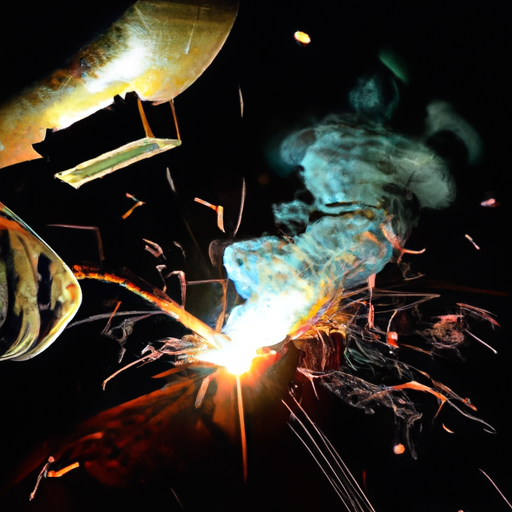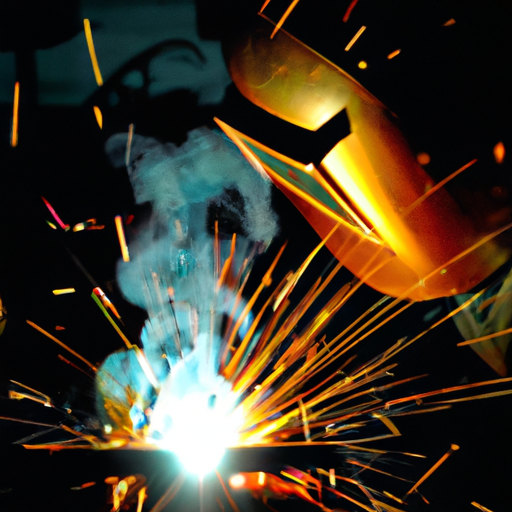Have you ever wondered what the easiest welding technique to learn is? Well, look no further! This article aims to provide you with a brief overview of various welding methods and highlight the one that is considered the easiest for beginners. Whether you’re a hobbyist looking to start a new project or someone interested in pursuing a career in welding, read on to find out which welding technique might be the best fit for you.
Understanding the basics of welding
Definition of welding
Welding is the process of joining two or more metallic pieces together by melting them and allowing them to cool and solidify. This creates a strong bond between the pieces, forming a permanent connection. It is a vital technique in industries such as construction, manufacturing, automotive, and aerospace, where the joining of metal components is essential for creating structures and products.
Brief history of welding
The practice of welding has been around for centuries, with evidence of its existence dating back to the Bronze Age. Ancient civilizations, such as the Egyptians and Greeks, utilized welding techniques to create decorative metal objects and repair tools and weapons. However, it wasn’t until the 19th century that welding as a profession began to take shape. Innovations in technology and the discovery of new welding processes catapulted the field into what it is today, enabling the construction of steel structures and the development of modern industrialization.
Different types of welding
There are various types of welding processes, each with its own characteristics and applications. Some of the most commonly used types of welding include:
-
Arc Welding: This is the most basic and versatile form of welding, where an electric arc is established between the workpiece and a welding electrode. It can be performed using different power sources, such as direct current (DC) or alternating current (AC).
-
TIG (Tungsten Inert Gas) Welding: TIG welding uses a non-consumable tungsten electrode to create the weld. A shielding gas, typically argon, is used to protect the weld from atmospheric contamination. It offers precise control over the welding process and is often used for delicate projects or welding non-ferrous metals.
-
MIG (Metal Inert Gas) Welding: MIG welding utilizes a consumable wire electrode and a shielding gas, usually a mixture of argon and carbon dioxide. It is known for its ease of use, high speed, and versatility, making it one of the most popular welding methods.
-
Flux-Cored Arc Welding: Similar to MIG welding, flux-cored arc welding also uses a continuous wire electrode, but with a flux-filled core. This eliminates the need for an external shielding gas, making it suitable for outdoor applications and windy conditions.
-
Submerged Arc Welding: In submerged arc welding, the weld is created by an arc between a continuously fed consumable electrode and the workpiece. The arc is submerged under a layer of flux, which shields it from the surrounding atmosphere and helps create a high-quality weld.
-
Stick Welding: Also known as shielded metal arc welding (SMAW), stick welding employs a consumable electrode covered in flux. The flux acts as a shield, protecting the weld pool from atmospheric contamination. It is widely used in construction, maintenance, and repair projects.
-
Plasma Arc Welding: Plasma arc welding utilizes a highly concentrated ionized gas called plasma to melt the metal and create a weld. This process provides exceptional control and precision, making it suitable for applications that require high-quality welds, such as the aerospace industry.
Factors that Affect the Difficulty of Learning Welding
Previous experience with manual skills
One of the factors that can greatly influence the difficulty of learning welding is your previous experience with manual skills. If you have a background in working with tools, understanding spatial relationships, and can easily grasp hand-eye coordination, you may find it easier to pick up welding techniques. Having a foundation in craftsmanship or hobbies such as woodworking, metalworking, or auto repair can offer a transferable skill set that can be applied to welding.
Access to appropriate welding equipment and tools
Learning welding can be challenging if you don’t have access to the appropriate equipment and tools. Welding requires specialized machinery such as welding machines, welding helmets, gloves, and other safety gear. Having access to a well-equipped welding shop or a training facility with proper welding setups can significantly contribute to the ease of the learning process. Investing in your own welding equipment can also provide you with the opportunity to practice and learn at your own pace.
Availability of suitable learning resources and instructors
The availability of suitable learning resources and experienced instructors can greatly impact the difficulty of learning welding. Having access to well-structured welding courses, instructional videos, books, and online tutorials can provide you with the necessary theoretical knowledge and guidance to understand welding techniques effectively. Additionally, having an experienced instructor or mentor who can provide hands-on training, offer feedback, and answer your questions will accelerate your learning progress.

Various Welding Processes
Arc Welding
Arc welding is a versatile welding process that is used in a wide range of applications. It is suitable for welding various types of metals, including steel, stainless steel, cast iron, and aluminum. Arc welding can be performed using different power sources, such as direct current (DC) or alternating current (AC). The process involves creating an electric arc between the workpiece and a welding electrode, which melts the metal and forms the weld.
TIG (Tungsten Inert Gas) Welding
TIG welding is a precise and clean welding process commonly used for joining non-ferrous metals such as aluminum, magnesium, and copper alloys. It utilizes a non-consumable tungsten electrode and a shielding gas, typically argon, to protect the weld from atmospheric contamination. TIG welding offers excellent control over the welding process, making it suitable for delicate projects and producing high-quality welds.
MIG (Metal Inert Gas) Welding
MIG welding is a popular welding process due to its ease of use, high speed, and versatility. It is suitable for welding a wide range of materials, including steel, stainless steel, aluminum, and copper alloys. MIG welding uses a consumable wire electrode and a shielding gas, usually a mixture of argon and carbon dioxide, to protect the weld from atmospheric contamination. The simplicity of the process makes it a common choice for beginners.
Flux-Cored Arc Welding
Flux-cored arc welding is similar to MIG welding but uses a flux-filled core in the wire electrode instead of relying on an external shielding gas. This makes it suitable for outdoor applications and windy conditions where maintaining a proper shielding gas coverage can be challenging. Flux-cored arc welding offers good penetration, high deposition rates, and is commonly used in construction, shipbuilding, and pipeline welding.
Submerged Arc Welding
Submerged arc welding is a process that employs an electric arc between a continuously fed consumable electrode and the workpiece. The arc is submerged under a layer of flux, which shields it from the surrounding atmosphere and helps create a high-quality weld. Submerged arc welding is often utilized in applications that require deep weld penetration, such as the welding of thick sections and the production of large structural components.
Stick Welding
Stick welding, also known as shielded metal arc welding (SMAW), is a versatile welding process commonly used in construction, maintenance, and repair projects. It involves using a consumable electrode covered in flux, which acts as a shield to protect the weld pool from atmospheric contamination. Stick welding is suitable for welding a wide range of metals and can be performed in various positions, making it a favorite among beginners and professionals alike.
Plasma Arc Welding
Plasma arc welding utilizes a highly concentrated ionized gas called plasma to melt the metal and create a weld. This process provides exceptional control and precision, making it suitable for applications that require high-quality welds, such as the aerospace industry. Plasma arc welding offers deeper weld penetration, reduced heat-affected zones, and increased welding speed compared to other welding methods.
MIG Welding: An Easy Technique to Start With
Why MIG welding is good for beginners
MIG welding is often regarded as an excellent technique for beginners due to its simplicity and ease of use. It requires minimal setup and preparation, making it suitable for individuals who are just starting their welding journey. The MIG welding process involves feeding a continuous wire electrode while simultaneously using a shielding gas to protect the weld from contamination. This eliminates the need for manually controlling an electrode like in stick welding, which can be more challenging for beginners.
The basic operating principles of MIG welding
MIG welding operates on the principle of creating an electric arc between the workpiece and a continuously fed consumable wire electrode. This arc generates intense heat, melting the metal and allowing it to fuse together. The wire electrode acts as a filler material, adding to the weld pool and providing strength and structure to the joint. The shielding gas, typically a mixture of argon and carbon dioxide, is used to protect the weld from the surrounding atmosphere and prevent oxidation.
Common applications of MIG welding
MIG welding finds widespread use in various industries and applications. It is commonly employed in automotive repair and fabrication, as it allows for fast and efficient welding of steel components. MIG welding is also utilized in the construction industry for joining structural steelwork. Its versatility extends to the manufacturing sector, where it is used for creating metal products, furniture, and appliances. Additionally, MIG welding is suitable for DIY projects, art installations, and other creative endeavors where metal needs to be joined together.

Detailed Guide on MIG Welding for Beginners
Understanding MIG Welding Equipment
To begin your MIG welding journey, it is essential to familiarize yourself with the equipment involved. The core components of a MIG welding setup include a welding machine, a welding gun or torch, a wire feeder, a roll of welding wire, and a gas cylinder for the shielding gas. Understanding how these components work together and their proper setup and operation is crucial for safe and effective MIG welding.
Setting Up the Welding Machine
Properly setting up the welding machine is crucial for achieving good welds and ensuring safety. This involves connecting the welding machine to a suitable power source, attaching the wire feeder and welding gun, and correctly configuring the machine’s settings for the specific welding application. It is essential to consult the welding machine’s manual and follow the manufacturer’s guidelines for the appropriate voltage, wire speed, and gas flow rate.
Safety Measures to Observe While MIG Welding
Safety should always be a top priority when engaging in any welding activity. When MIG welding, it is crucial to wear appropriate personal protective equipment (PPE), including a welding helmet with a proper shade lens, welding gloves, a welding jacket or apron, and safety glasses. Adequate ventilation in the welding area is important to prevent the accumulation of harmful fumes and gases. It is also essential to maintain a clean and clutter-free workspace to reduce the risk of accidents.
Hands-On Practice: Simple Welding Projects for MIG Beginners
To gain proficiency in MIG welding, hands-on practice is essential. Starting with simple welding projects can provide a practical application of the techniques learned and help build confidence. Some beginner-friendly welding projects for MIG welding include welding together small metal pieces to create a sculpture or decorative item, fabricating a basic metal frame, or repairing a broken metal object. It is important to start with small and manageable projects that match your skill level to ensure a positive learning experience.
Stick Welding: Another Beginner-Friendly Process
Why beginners might choose stick welding
Stick welding, also known as shielded metal arc welding (SMAW), is a versatile process that can be a great choice for beginners. One of the reasons why beginners might choose stick welding is the affordability and accessibility of the equipment. Stick welding machines are relatively inexpensive compared to other welding processes, making it a cost-effective option for those just starting out. Additionally, stick welding can be performed in various positions and on a wide range of metals, providing more flexibility in terms of project selection.
Overview of stick welding equipment
Stick welding requires a welding machine, welding cables, an electrode holder, and a ground clamp. The core component is the electrode, which consists of a metal rod covered in a flux coating. The flux coating serves as a shield, protecting the weld pool from atmospheric contamination. Understanding the setup and operation of stick welding equipment is essential to ensure safety and efficiency during the welding process.
Common applications for stick welding
Stick welding finds application in various industries and project types. It is commonly used in construction, particularly for welding structural steel, steel beams, and columns. Stick welding is also employed in field repair and maintenance projects, where versatility and portability are essential. Its ability to perform well in outdoor and adverse weather conditions makes it a preferred choice for pipelines, bridges, and shipbuilding.

Step-by-Step Instructions for Stick Welding
Understanding the Equipment and Materials
Before starting stick welding, it is crucial to understand the equipment and materials involved. Familiarize yourself with the welding machine, electrode holder, ground clamp, and the different types of electrodes available. Understanding the properties and applications of various electrode types, such as low-hydrogen, cellulose, and rutile, will help you select the most suitable electrode for your specific project.
Setting Up the Welding Machine
Properly setting up the welding machine is essential for achieving desired weld quality. Connect the welding machine to a suitable power source and ensure the machine is correctly configured for the welding application at hand. Adjust the amperage setting according to the electrode’s manufacturer recommendations to prevent overheating or underheating of the weld.
Basic Techniques for Creating a Weld Using Stick Welding
Stick welding involves a few basic techniques that are essential for creating strong and visually appealing welds. Key techniques include striking the arc, maintaining a steady arc length, and keeping a consistent travel speed. Striking the arc refers to initiating the welding process by creating an arc between the electrode and the workpiece. Maintaining a steady arc length ensures proper heat input and penetration. A consistent travel speed is crucial to produce uniform welds without excessive buildup or lack of fusion.
Comparison: MIG Welding vs Stick Welding
Ease of learning
Both MIG welding and stick welding are relatively beginner-friendly processes, but MIG welding is often considered easier to learn. MIG welding offers more control and requires less manual dexterity, as the wire electrode is continuously fed into the weld pool. Stick welding involves manually controlling the electrode, which can be more challenging for beginners to master.
Quality of Weld
In terms of weld quality, both MIG welding and stick welding can produce strong and reliable welds when performed correctly. MIG welding typically offers cleaner and more visually appealing welds due to the ability to control the wire feed and shielding gas. Stick welding can be more forgiving in terms of surface contamination and wind conditions, making it suitable for outdoor applications where cleanliness is more challenging to maintain.
Versatility
MIG welding offers greater versatility in terms of the materials that can be welded. It is suitable for welding steel, stainless steel, aluminum, and various other metals. Stick welding, on the other hand, is more limited in terms of material compatibility, with a primary focus on steel and cast iron applications.
Materials used
MIG welding uses a consumable wire electrode, typically made of stainless steel, carbon steel, or aluminum. Stick welding uses a consumable electrode covered in a flux coating, offering versatility with different types of electrodes for various applications.
Safety considerations
Both MIG welding and stick welding require adherence to safety practices. However, MIG welding generally produces less smoke, fumes, and spatter compared to stick welding. The shielding gas used in MIG welding helps protect the welder from harmful fumes, while stick welding may produce more visible smoke and spatter, requiring adequate ventilation and protective measures.

After Mastering MIG and Stick, What’s Next?
Overview of more complex welding methods
After mastering MIG and stick welding, you may consider exploring more complex welding methods. Some of these methods include TIG welding, flux-cored arc welding, plasma arc welding, and specialized processes like laser welding and electron beam welding. These advanced techniques offer greater precision, control, and specialization, catering to specific industries and applications.
When to consider learning TIG (Tungsten Inert Gas) welding
TIG welding is an excellent choice for those seeking to improve their welding skills further, especially if working with non-ferrous metals is of interest. TIG welding requires a higher level of manual dexterity and control compared to MIG and stick welding, but it offers exceptional weld quality and versatility. Consider learning TIG welding when you are comfortable with the fundamentals of MIG and stick welding and ready to explore new challenges.
What to know about learning Flux-Cored Arc Welding
Flux-cored arc welding is another process worth exploring after mastering MIG and stick welding. It offers enhanced versatility and performance in outdoor applications where shielding gas coverage may be challenging due to wind or ambient conditions. Learning flux-cored arc welding involves understanding the different types of flux-cored wires, adjusting wire feed speeds and gas flow rates, and practicing proper techniques to achieve optimal weld quality.
Resources for Further Learning
Reputable online welding courses and tutorials
There are numerous online platforms that offer reputable welding courses and tutorials, providing in-depth knowledge and practical guidance for individuals interested in learning or improving their welding skills. Websites like Udemy, Coursera, and LinkedIn Learning offer a wide range of welding courses that cater to different levels of expertise, from beginners to advanced welders. These courses often include video lessons, hands-on exercises, quizzes, and certifications upon completion.
Local vocational and technical schools offering welding
Another valuable resource for learning welding is local vocational and technical schools. These institutions often offer comprehensive welding programs that cover various welding processes, safety practices, and hands-on training. Vocational schools provide access to well-equipped welding labs and experienced instructors who can guide you through the learning process and offer personalized feedback and support.
Professional communities and forums for new welders
Engaging with professional communities and online forums dedicated to welding can provide a wealth of knowledge and support. Platforms like WeldingWeb and Reddit’s welding subreddit offer spaces for welders of all levels to connect, share experiences, ask questions, and gain insights from experienced professionals. These communities can provide valuable tips, troubleshooting advice, and recommendations for further learning resources. Participating in welding forums can help you expand your network and connect with others who share your passion for welding.
In conclusion, welding is a valuable skill that opens up a world of opportunities in various industries. Understanding the basics of welding, including different types of welding processes and the factors that affect the difficulty of learning, is essential for beginners. MIG welding and stick welding are two beginner-friendly processes that offer an excellent starting point for individuals interested in learning to weld. By following step-by-step instructions, practicing hands-on projects, and observing safety protocols, beginners can develop their skills and progress to more complex welding methods like TIG welding and flux-cored arc welding. Reputable online courses, vocational schools, and professional communities provide valuable resources and support for further learning, helping individuals become proficient welders and embark on a rewarding welding career.

